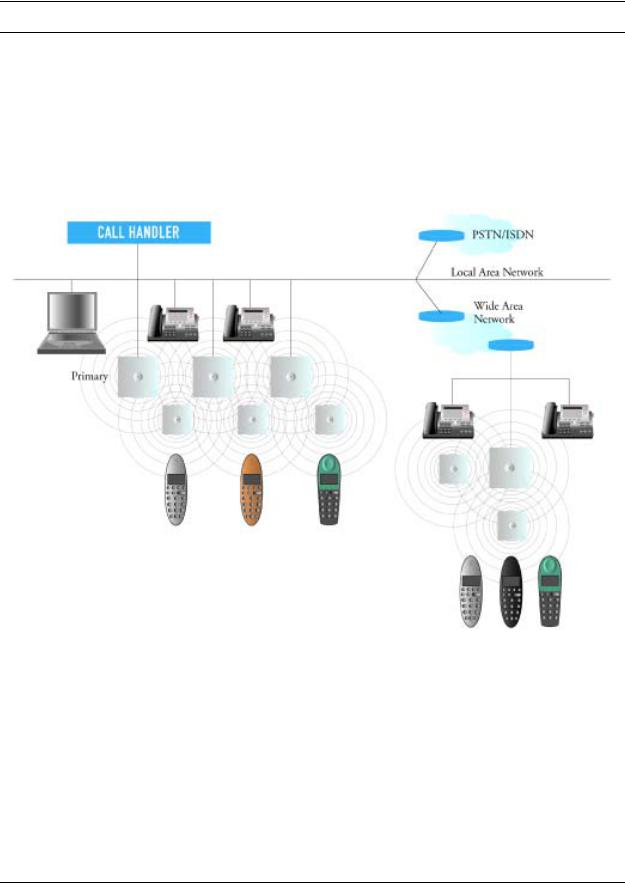Polycom KIRK WIRELESS SERVER 600V3 Manual

Part No. 14117800, Ed.3.0
September 28, 2010
Polycom® KIRK® Wireless Server 600v3
Installation and Configuration Guide

2
Copyright © Polycom, Inc.
All Rights Reserved
Catalog No. 14117800
Version 3.0
Proprietary and Confidential
The information contained herein is the sole intellectual property of Polycom, Inc. No distribution, reproduction or unauthorized use of these materials is permitted without the expressed written consent of Polycom, Inc. Information contained herein is subject to change without notice and does not represent commitment of any type on the part of Polycom, Inc. Polycom and Accord are registered trademarks of Polycom, Inc.
Notice
While reasonable effort was made to ensure that the information in this document was complete and accurate at the time of printing, Polycom, Inc., cannot assume responsibility for any errors. Changes and/or corrections to the information contained in this document may be incorporated into future issues.
14117800, Ed.3.0

|
|
Contents |
3 |
|
|
|
|
Contents |
|
|
|
Chapter 1 |
Preface........................................................................................................ |
15 |
|
1.1 |
Before You Begin...................................................................................................... |
16 |
|
1.2 |
Chapter Overview..................................................................................................... |
17 |
|
1.3 |
Related Documentation ............................................................................................ |
18 |
|
1.4 |
Acronyms.................................................................................................................. |
19 |
|
Chapter 2 |
Introduction................................................................................................ |
21 |
|
2.1 |
Components of the KIRK Wireless Server 600v3 Solution....................................... |
22 |
|
|
2.1.1 |
KIRK Wireless Server 600v3........................................................................... |
22 |
|
2.1.2 |
Wireless Bands ............................................................................................... |
23 |
|
2.1.3 KIRK Repeater ................................................................................................ |
23 |
|
|
2.1.4 KIRK Handset ................................................................................................. |
24 |
|
|
2.1.5 |
KIRK SIO Application Interface ....................................................................... |
25 |
|
2.1.6 KIRK Maintenance Software ........................................................................... |
25 |
|
2.2 |
Requirements for the KIRK Wireless Server 600v3 Solution.................................... |
26 |
|
|
2.2.1 |
KIRK Wireless Server 600v3........................................................................... |
26 |
|
2.2.2 KIRK Repeater ................................................................................................ |
27 |
|
|
2.2.3 KIRK Handsets................................................................................................ |
28 |
|
|
2.2.4 KIRK Maintenance Software ........................................................................... |
29 |
|
Chapter 3 Deploying KIRK Wireless Server 600v3 .................................................. |
31 |
||
3.1 |
Recommendations for KWS600v3/KIRK Repeater Placement ................................ |
32 |
|
3.2 |
Deployment of a KIRK Wireless Server 600v3 Multi-Cell......................................... |
32 |
|
|
3.2.1 |
Sync over Air................................................................................................... |
32 |
|
3.2.2 |
Examples of Synchronization Chains.............................................................. |
33 |
Chapter 4 Installing the KIRK Wireless Server 600v3.............................................. |
41 |
||
4.1 |
Unpacking................................................................................................................. |
41 |
|
|
4.1.1 |
Inspect for Damage......................................................................................... |
41 |
|
4.1.2 |
Unpacking the Shipping Container.................................................................. |
41 |
4.2 |
Description of KIRK Wireless Server 600v3 ............................................................. |
41 |
|
|
4.2.1 KIRK Wireless Server 600v3 Provides RF Channels to KIRK Handsets ........ |
42 |
|
|
4.2.2 KIRK Wireless Server 600v3 Types and Part Numbers.................................. |
42 |
|
|
4.2.3 KIRK Wireless Server 600v3 Appearance and Components.......................... |
42 |
|
|
4.2.4 |
KIRK Wireless Server 600v3 LED Indicators .................................................. |
44 |
|
4.2.5 |
KIRK Wireless Server 600v3 - Reset Button................................................... |
45 |
4.3 |
Installing the KIRK Wireless Server 600v3 ............................................................... |
46 |
|
|
4.3.1 |
KIRK Wireless Server 600v3 Indoor Wall Mounting........................................ |
47 |
4.4 |
Recording the Installation Information ...................................................................... |
48 |
|
KIRK Wireless Server 600v3 Installation and Configuration Guide

4
Chapter 5 Installing the KIRK Repeater .................................................................... |
49 |
||
5.1 |
KIRK Repeater Description ...................................................................................... |
49 |
|
|
5.1.1 KIRK Repeater provides RF Channels to KIRK Handsets.............................. |
49 |
|
|
5.1.2 KIRK Repeater Types and Part Numbers ....................................................... |
50 |
|
|
5.1.3 KIRK Repeater - Appearance and Components ............................................. |
51 |
|
|
5.1.4 |
KIRK Repeater LED Indicators ....................................................................... |
51 |
|
5.1.5 |
Installing the KIRK Repeater........................................................................... |
51 |
5.2 |
Checking Indicators .................................................................................................. |
54 |
|
5.3 |
Powering the KIRK Repeater ................................................................................... |
54 |
|
|
5.3.1 |
Power Options................................................................................................. |
54 |
5.4 |
Programming a KIRK Repeater with the KIRK Programming Kit ............................. |
54 |
|
|
5.4.1 |
Content of the KIRK Programming Kit Repeater............................................. |
54 |
|
5.4.2 |
Set up of the Hardware for Repeater Programming........................................ |
55 |
|
5.4.3 |
Programming the KIRK Repeater with the ServiceTool .................................. |
55 |
5.5 |
Use of KIRK Repeater With External Antenna ......................................................... |
64 |
|
|
5.5.1 |
Synchronization Ways..................................................................................... |
64 |
Chapter 6 Preparing KIRK Handset for Use ............................................................. |
65 |
||
6.1 |
Unpacking................................................................................................................. |
65 |
|
|
6.1.1 |
Inspect for Damage......................................................................................... |
65 |
|
6.1.2 |
Unpacking the Shipping Container.................................................................. |
65 |
6.2 |
KIRK Handset Description........................................................................................ |
65 |
|
|
6.2.1 KIRK Handset Types....................................................................................... |
66 |
|
|
6.2.2 KIRK Charger Types and Part Numbers ......................................................... |
66 |
|
6.3 |
Installing Battery ....................................................................................................... |
67 |
|
|
6.3.1 |
Installing Battery on KIRK 3040 Handsets ...................................................... |
68 |
6.4 |
Installing Battery on KIRK 4020/KIRK 4040/KIRK 4080 Handsets........................... |
68 |
|
|
6.4.1 |
Installing Battery on KIRK 5020 / 5040 Handsets ........................................... |
69 |
6.5 |
Charging KIRK Handsets.......................................................................................... |
70 |
|
|
6.5.1 |
Using the Charger ........................................................................................... |
70 |
|
6.5.2 |
Charging Battery ............................................................................................. |
72 |
6.6 |
Retrieving the Serial Number of the KIRK Handset.................................................. |
73 |
|
|
6.6.1 Retrieving Serial Number on KIRK 3040 Handsets ........................................ |
74 |
|
|
6.6.2 Retrieving Serial Number on KIRK 4020/KIRK 4040/KIRK 4080 Handsets.... |
74 |
|
|
6.6.3 |
Retrieving Serial Number on KIRK 5020 / 5040 Handsets ............................. |
75 |
Chapter 7 Configuring KIRK Wireless Server 600v3 ............................................... |
77 |
||
7.1 |
Powering up the KIRK Wireless Server 600v3 ......................................................... |
77 |
|
|
7.1.1 |
Power over Ethernet (PoE) ............................................................................. |
77 |
|
7.1.2 |
Checking Indicators......................................................................................... |
77 |
7.2 |
Connecting a Computer to the KIRK Wireless Server 600v3 ................................... |
78 |
|
7.3 |
Accessing the Web Based Administration Page....................................................... |
78 |
|
14117800, Ed.3.0

|
|
Contents |
5 |
|
|
|
|
|
7.3.1 |
How to Change Internet Protocol Properties using Windows XP.................... |
79 |
|
7.3.2 |
How to Access the Administration Page ......................................................... |
80 |
7.4 |
Accessing the KIRK Configuration Tool.................................................................... |
81 |
|
|
7.4.1 |
Installing the KIRK Configuration Tool............................................................. |
81 |
|
7.4.2 |
Starting the KIRK Configuration Tool............................................................... |
81 |
7.5 |
Configuring Single-Cell Solution through Administration Page................................. |
82 |
|
|
7.5.1 Entering a System User Name and Password................................................ |
83 |
|
|
7.5.2 |
Assigning a Specific IP Address...................................................................... |
84 |
|
7.5.3 |
Configuring Ethernet Link................................................................................ |
86 |
|
7.5.4 Configuring DECT System .............................................................................. |
87 |
|
|
7.5.5 Configuring DECT Master ............................................................................... |
88 |
|
|
7.5.6 Configuring DECT Radio................................................................................. |
89 |
|
|
7.5.7 |
Configuring TOS (Type of Service) Priorities .................................................. |
89 |
7.6 |
Configuring Multi-Cell Solution through Administration Page................................... |
90 |
|
|
7.6.1 |
Configuring the IP Master (Primary) KIRK Wireless Server 600v3 ................. |
91 |
|
7.6.2 |
Configuring Sync Master............................................................................... |
100 |
|
7.6.3 |
Configuring the Alternative Master KIRK Wireless Server 600v3 ................. |
104 |
|
7.6.4 |
Configuring the Secondary KIRK Wireless Server 600v3 ............................. |
108 |
|
7.6.5 Configuring Secondary KWS600v3 Using a Back-Up File............................ |
117 |
|
|
7.6.6 |
Configuring Standalone LDAP Server........................................................... |
117 |
|
7.6.7 |
Configuring Alternative LDAP Server............................................................ |
120 |
7.7 |
Configuring Single-Cell Solution through KIRK Configuration Tool ........................ |
122 |
|
7.8 |
Configuring Multi-Cell Solution through KIRK Configuration Tool........................... |
125 |
|
|
7.8.1 |
Configuring the Master (Primary) KIRK Wireless Server 600v3 ................... |
126 |
|
7.8.2 |
Configuring the Alternative Master KIRK Wireless Server 600v3 ................. |
129 |
|
7.8.3 |
Configuring LDAP Server.............................................................................. |
132 |
|
7.8.4 |
Configuring Alternative LDAP Server............................................................ |
134 |
|
7.8.5 |
Configuring Sync Master............................................................................... |
136 |
|
7.8.6 |
Configuring the Secondary KIRK Wireless Server 600v3 ............................. |
137 |
|
7.8.7 |
Saving Configurations ................................................................................... |
141 |
|
7.8.8 |
Uploading Configuration Files ....................................................................... |
141 |
|
7.8.9 |
Opening Configuration Files.......................................................................... |
144 |
Chapter 8 KIRK Handset Registration and Subscription ...................................... |
145 |
||
8.1 |
Registering KIRK Handsets .................................................................................... |
145 |
|
|
8.1.1 |
Registering Handsets Using Skinny Protocol................................................ |
145 |
|
8.1.2 |
Registering Handsets Using H.323 Protocol................................................. |
147 |
|
8.1.3 |
Registering Handsets Using SIP Protocol..................................................... |
149 |
8.2 |
Subscribing KIRK Handsets ................................................................................... |
152 |
|
|
8.2.1 KIRK 3040 Handset ...................................................................................... |
152 |
|
|
8.2.2 KIRK 4020/4040/4080 Handset .................................................................... |
154 |
|
|
8.2.3 KIRK 5020 / 5040 Handset ........................................................................... |
156 |
|
KIRK Wireless Server 600v3 Installation and Configuration Guide

6
Chapter 9 KIRK Handset Management.................................................................... |
159 |
||
9.1 |
Viewing Handset/User Configuration...................................................................... |
159 |
|
9.2 |
Searching for Handset/User Information ................................................................ |
160 |
|
9.3 |
Unsubscribing KIRK Handsets ............................................................................... |
160 |
|
|
9.3.1 KIRK 3040/4020/4040/4080 Handset ........................................................... |
160 |
|
|
9.3.2 KIRK 5020 / 5040 Handset ........................................................................... |
161 |
|
9.4 |
Removing KIRK Handsets from the List (Deregistering) ........................................ |
161 |
|
9.5 |
Changing User Configurations ............................................................................... |
162 |
|
9.6 |
Adjusting the KIRK Handset ................................................................................... |
163 |
|
|
9.6.1 Content of the KIRK Programming Kit Handset ............................................ |
163 |
|
|
9.6.2 |
Set up of the Hardware for KIRK Handset Adjustment ................................. |
164 |
|
9.6.3 |
Adjusting the KIRK Handset with the ServiceTool......................................... |
164 |
Chapter 10 |
System Management............................................................................. |
165 |
|
10.1 Using the Web Based Administration Page.......................................................... |
165 |
||
10.1.1 Changing System User Name and Password............................................. |
165 |
||
10.1.2 |
Reading System Information....................................................................... |
166 |
|
10.1.3 |
Reading DECT Statistics............................................................................. |
167 |
|
10.1.4 Reading LDAP Server Status...................................................................... |
171 |
||
10.1.5 |
Reading LDAP Replicator Statistics ............................................................ |
171 |
|
10.1.6 |
Reading Ethernet Statistics ......................................................................... |
172 |
|
10.1.7 |
Diagnostics.................................................................................................. |
173 |
|
10.1.8 |
Making a Back-Up of the Configuration File................................................ |
176 |
|
10.1.9 |
Updating the KIRK Wireless Server 600v3 ................................................. |
177 |
|
10.1.10 |
Resetting the KIRK Wireless Server 600v3 .............................................. |
181 |
|
10.2 |
Using the ServiceTool........................................................................................... |
183 |
|
10.2.1 KIRK Repeater Programming ..................................................................... |
183 |
||
10.2.2 |
Adjusting the KIRK Handset........................................................................ |
184 |
|
Chapter 11 Messaging over MSF ............................................................................. |
185 |
|
11.1 |
Description of Different Types of MSF Messages................................................. |
185 |
11.2 |
Activating MSF Messages Function...................................................................... |
186 |
11.3 |
Sending Text Messages........................................................................................ |
187 |
Chapter 12 |
Configuration/General/Update ............................................................. |
189 |
12.1 |
Current Update Serials ......................................................................................... |
190 |
Chapter 13 Configuration of the Update Server..................................................... |
191 |
|
13.1 |
System Requirements .......................................................................................... |
191 |
13.2 |
Installation............................................................................................................. |
191 |
13.3 |
Configuration ........................................................................................................ |
191 |
13.4 |
Running Maintenance........................................................................................... |
192 |
13.5 |
Maintenance Commands...................................................................................... |
192 |
14117800, Ed.3.0

Contents |
7 |
|
|
13.5.1 Check Command ........................................................................................ |
192 |
13.5.2 Times Command ......................................................................................... |
192 |
13.5.3 Prot Command ............................................................................................ |
193 |
13.5.4 Boot Command ........................................................................................... |
194 |
13.5.5 Bmc command (only for DECT devices) ..................................................... |
194 |
13.5.6 SCFG Command......................................................................................... |
195 |
13.5.7 Example ...................................................................................................... |
196 |
Chapter 14 Configuration of an NTP Server / Client .............................................. |
197 |
|
14.1 |
Configuration ........................................................................................................ |
197 |
14.2 |
Timezone Configuration String ............................................................................. |
197 |
14.3 |
Example................................................................................................................ |
198 |
Chapter 15 |
Troubleshooting .................................................................................... |
199 |
|
15.1 |
Solving Problems in KIRK Wireless Server 600v3 ............................................... |
199 |
|
15.1.1 |
Administration Page of the KIRK Wireless Server 600v3 ........................... |
199 |
|
15.1.2 |
KIRK Configuration Tool for KIRK Wireless Server 600v3 .......................... |
200 |
|
15.1.3 KIRK Repeater ............................................................................................ |
201 |
||
15.1.4 KIRK Handset ............................................................................................. |
201 |
||
15.2 |
Should You Need to Report a Problem................................................................. |
201 |
|
15.3 |
Frequently Asked Questions ................................................................................ |
202 |
|
15.4 |
Using the GWLOAD Program............................................................................... |
202 |
|
Chapter 16 |
Regulatory Notices................................................................................ |
205 |
16.1 |
International Regulatory and Product Information ................................................ |
205 |
16.2 |
Explosive Device Proximity Warning .................................................................... |
208 |
16.3 |
Important Safety Instructions and Product Information......................................... |
210 |
16.4 |
Intrinsic safety....................................................................................................... |
211 |
16.5 |
Exposure to sunlight, heat and moisture .............................................................. |
211 |
16.6 |
Spare parts and accessories ................................................................................ |
212 |
16.7 |
Power failure......................................................................................................... |
212 |
16.8 |
NOTICES.............................................................................................................. |
213 |
16.9 |
LIMITED WARRANTY .......................................................................................... |
214 |
KIRK Wireless Server 600v3 Installation and Configuration Guide

8
14117800, Ed.3.0

|
|
Figures 9 |
Figures |
|
|
Figure 1 |
Overview of the Whole Solution . . . . . . . . . . . . . . . . . . . . . . . . . . |
. . . 21 |
Figure 1 |
Synchronization Chain . . . . . . . . . . . . . . . . . . . . . . . . . . . . . . . . . |
. . . 34 |
Figure 2 |
Synchronization Chain Layout without Alternative Sync Ways. . . . |
. . 34 |
Figure 3 |
Synchronization Chain with Alternative Sync Ways . . . . . . . . . . . . |
. . 35 |
Figure 4 |
Synchronization Chain with Alternative Sync Ways . . . . . . . . . . . . |
. . 36 |
Figure 5 |
Synchronization Chain with Alternative Sync Ways . . . . . . . . . . . . |
. . 36 |
Figure 6 |
Synchronization Chain Layout with Alternative Sync Ways . . . . . . |
. . 37 |
Figure 7 |
Synchronization Chain With and Without Alternative Sync Ways |
. . . 38 |
Figure 8 |
Synchronization Chain With Repeaters . . . . . . . . . . . . . . . . . . . . . |
. . 39 |
Figure 9 |
Wireless Server 600v3 - Front view . . . . . . . . . . . . . . . . . . . . . . . . |
. . 43 |
Figure 10 |
Wireless Server 600v3 - Faceplate. . . . . . . . . . . . . . . . . . . . . . . . . |
. . 44 |
Figure 11 |
Wireless Server 600v3 Wall Mounting . . . . . . . . . . . . . . . . . . . . . . |
. . 47 |
Figure 1 |
Remove Back Cover from Handset . . . . . . . . . . . . . . . . . . . . . . . . |
. . 68 |
Figure 2 |
Remove Back Cover from Handset with Screw Fastener. . . . . . . . |
. . 69 |
Figure 3 |
Remove Back Cover from Handset . . . . . . . . . . . . . . . . . . . . . . . . |
. . 69 |
Figure 4 |
Single Charger for 3040 Handset . . . . . . . . . . . . . . . . . . . . . . . . . . |
. . 70 |
Figure 5 |
Single Charger for 4020 Handset and 4040 Handset. . . . . . . . . . . |
. . 70 |
Figure 6 |
Single Charger for 4080 Handset . . . . . . . . . . . . . . . . . . . . . . . . . . |
. . 71 |
Figure 7 |
Multicharger for 4020 Handset and 4040 Handset. . . . . . . . . . . . . |
. . 71 |
Figure 8 |
Single Charger for 5020 / 5040 Handset . . . . . . . . . . . . . . . . . . . . |
. . 71 |
Figure 9 |
Remove Back Cover from Handset . . . . . . . . . . . . . . . . . . . . . . . . |
. . 74 |
Figure 10 |
Remove Back Cover from Handset with Screw Fastener. . . . . . . . |
. . 75 |
Figure 11 |
Remove Back Cover from Handset . . . . . . . . . . . . . . . . . . . . . . . . |
. . 75 |
Figure 12 |
Standard LAN Patch Cable (RJ45) . . . . . . . . . . . . . . . . . . . . . . . . . |
. . 78 |
Figure 13 |
Local Area Connection Properties dialog box. . . . . . . . . . . . . . . . . |
. . 79 |
Figure 14 |
Internet Protocol Properties dialog box. . . . . . . . . . . . . . . . . . . . . . |
. . 80 |
Figure 15 |
Main page of the Web Based Administration Page . . . . . . . . . . . . |
. . 81 |
Figure 16 |
Configuration Tool startup window . . . . . . . . . . . . . . . . . . . . . . . . . |
. . 82 |
Figure 17 |
Wireless Server 600v3 Single-cell installation . . . . . . . . . . . . . . . . |
. . 83 |
Figure 18 |
Adm. Page: Enter Network Password dialog box . . . . . . . . . . . . . . |
. . 84 |
Figure 19 |
Adm. Page: Configuration/ETH0/DHCP page . . . . . . . . . . . . . . . . |
. . 84 |
Figure 20 |
Adm. Page: Configuration/ETH0/IP page . . . . . . . . . . . . . . . . . . . . |
. . 85 |
Figure 21 |
Adm. Page: Configuration/ETH0/Link page . . . . . . . . . . . . . . . . . . |
. . 86 |
Figure 22 |
Adm. Page: Configuration/DECT/System page . . . . . . . . . . . . . . . |
. . 87 |
Figure 23 |
Adm. Page: Configuration/DECT/Master page. . . . . . . . . . . . . . . . |
. . 88 |
Figure 24 |
Adm. Page: Configuration/DECT/Radio page . . . . . . . . . . . . . . . . |
. . 89 |
Figure 25 |
Adm. Page: Configuration/IP/Settings page . . . . . . . . . . . . . . . . . . |
. . 90 |
Figure 26 |
Wireless Server 600v3 Multi-cell installation . . . . . . . . . . . . . . . . . |
. . 91 |
Figure 27 |
Adm. Page: Enter Network Password dialog box . . . . . . . . . . . . . . |
. . 92 |
KIRK Wireless Server 600v3 Installation and Configuration Guide

10 Figures
Figure 28 Adm. Page: Configuration/ETH0/DHCP page . . . . . . . . . . . . . . . . . . 93 Figure 29 Adm. Page: Configuration/ETH0/IP page . . . . . . . . . . . . . . . . . . . . . . 93 Figure 30 Adm. Page: Configuration/General/License page . . . . . . . . . . . . . . . 94 Figure 31 Adm. Page: Configuration/ETH0/Link page . . . . . . . . . . . . . . . . . . . . 95 Figure 32 Adm. Page: Configuration/LDAP/Server page . . . . . . . . . . . . . . . . . . 95 Figure 33 Adm. Page: Configuration/DECT/System page . . . . . . . . . . . . . . . . . 96 Figure 34 Adm. Page: Configuration/DECT/Master page. . . . . . . . . . . . . . . . . . 98 Figure 35 Adm. Page: Configuration/DECT/Radio page . . . . . . . . . . . . . . . . . . 99 Figure 36 Adm. Page: Configuration/IP/Settings page . . . . . . . . . . . . . . . . . . . . 99 Figure 37 Adm. Page: Configuration/ETH0/DHCP page . . . . . . . . . . . . . . . . . 101 Figure 38 Adm. Page: Configuration/ETH0/IP page . . . . . . . . . . . . . . . . . . . . . 101 Figure 39 Adm. Page: Configuration/LDAP/Replicator page . . . . . . . . . . . . . . 102 Figure 40 Adm. Page: Configuration/DECT/Master page. . . . . . . . . . . . . . . . . 103 Figure 41 Adm. Page: Configuration/DECT/Radio page . . . . . . . . . . . . . . . . . 103 Figure 42 KWS600v3 Multi-cell installation with Alternative (Standby) Master. 104 Figure 43 Adm. Page: Enter Network Password dialog box . . . . . . . . . . . . . . . 105 Figure 44 Adm. Page: Configuration/ETH0/DHCP page . . . . . . . . . . . . . . . . . 106 Figure 45 Adm. Page: Configuration/ETH0/IP page . . . . . . . . . . . . . . . . . . . . . 106 Figure 46 Adm. Page: Configuration/ETH0/Link page . . . . . . . . . . . . . . . . . . . 107 Figure 47 Adm. Page: Configuration/DECT/Master page. . . . . . . . . . . . . . . . . 107 Figure 48 Adm. Page: Configuration/DECT/Radio page . . . . . . . . . . . . . . . . . 108 Figure 49 WS600v3 Multi-cell installation (primary and secondaries) . . . . . . . 109 Figure 50 Adm. Page: Enter Network Password dialog box . . . . . . . . . . . . . . . 110 Figure 51 Adm. Page: Configuration/ETH0/DHCP page . . . . . . . . . . . . . . . . . 111 Figure 52 Adm. Page: Configuration/ETH0/IP page . . . . . . . . . . . . . . . . . . . . . 111 Figure 53 Adm. Page: Configuration/ETH0/Link page . . . . . . . . . . . . . . . . . . . 112 Figure 54 Adm. Page: Configuration/LDAP/Replicator page . . . . . . . . . . . . . . 113 Figure 55 Adm. Page: Configuration/DECT/Master page. . . . . . . . . . . . . . . . . 114 Figure 56 Adm. Page: Configuration/DECT/System page . . . . . . . . . . . . . . . . 115 Figure 57 Adm. Page: Configuration/DECT/Radio page . . . . . . . . . . . . . . . . . 116 Figure 58 Wireless Server 600v3 Multi-cell installation with LDAP Server . . . . 118 Figure 59 Adm. Page: Configuration/LDAP/Server page . . . . . . . . . . . . . . . . . 118 Figure 60 Adm. Page: Configuration/DECT/Master page. . . . . . . . . . . . . . . . . 119 Figure 61 Adm. Page: Configuration/DECT/Radio page . . . . . . . . . . . . . . . . . 119 Figure 62 WS600v3 Multi-cell installation with Alternative LDAP Server . . . . . 120 Figure 63 Adm. Page: Configuration/LDAP/Server page . . . . . . . . . . . . . . . . . 121 Figure 64 Adm. Page: Configuration/LDAP/Replicator page . . . . . . . . . . . . . . 122 Figure 65 Wireless Server 600v3 Single-cell installation . . . . . . . . . . . . . . . . . 123 Figure 66 Configuration Tool: Master tab . . . . . . . . . . . . . . . . . . . . . . . . . . . . . 123 Figure 67 Wireless Server 600v3 Multi-cell installation . . . . . . . . . . . . . . . . . . 126 Figure 68 Configuration Tool: Master tab . . . . . . . . . . . . . . . . . . . . . . . . . . . . . 127 Figure 69 WS600v3 Multi-cell installation with Alternative (Standby) Master . . 130
14117800, Ed.3.0

Figures 11
Figure 70 Configuration Tool: Alt Master tab. . . . . . . . . . . . . . . . . . . . . . . . . . . 130 Figure 71 Wireless Server 600v3 Multi-cell installation with LDAP Server . . . . 132 Figure 72 Configuration Tool: LDAP Server tab . . . . . . . . . . . . . . . . . . . . . . . . 133 Figure 73 WS600v3 Multi-cell installation with Alternative LDAP Server . . . . . 134 Figure 74 Configuration Tool: Alt LDAP Server tab. . . . . . . . . . . . . . . . . . . . . . 135 Figure 75 Configuration Tool: Sync Master tab. . . . . . . . . . . . . . . . . . . . . . . . . 136 Figure 76 WS600v3 Multi-cell installation (primary and secondaries) . . . . . . . 138 Figure 77 Configuration Tool: Secondaries tab. . . . . . . . . . . . . . . . . . . . . . . . . 139 Figure 78 Configuration Tool: Secondary Settings dialog box . . . . . . . . . . . . . 140 Figure 79 Configuration Tool: Save dialog box . . . . . . . . . . . . . . . . . . . . . . . . . 141 Figure 80 Configuration Tool: Select files to upload dialog box . . . . . . . . . . . . 142 Figure 81 Configuration Tool: Upload dialog box . . . . . . . . . . . . . . . . . . . . . . . 143 Figure 82 Configuration Tool: Select config. text file to open dialog box . . . . . 144 Figure 83 Adm. Page: Administration/DECT/Users page . . . . . . . . . . . . . . . . . 146 Figure 84 Adm. Page: Edit User dialog box . . . . . . . . . . . . . . . . . . . . . . . . . . . 146 Figure 85 Adm. Page: Administration/DECT/Users page . . . . . . . . . . . . . . . . . 148 Figure 86 Adm. Page: Edit User dialog box . . . . . . . . . . . . . . . . . . . . . . . . . . . 148 Figure 87 Adm. Page: Administration/DECT/Users page . . . . . . . . . . . . . . . . . 150 Figure 88 Adm. Page: Edit User dialog box . . . . . . . . . . . . . . . . . . . . . . . . . . . 150 Figure 89 Adm. Page: Administration/DECT/Users page . . . . . . . . . . . . . . . . . 159 Figure 90 Adm. Page: Administration/DECT/Users page . . . . . . . . . . . . . . . . . 160 Figure 91 Adm. Page: Administration/DECT/Users page . . . . . . . . . . . . . . . . . 161 Figure 92 Adm. Page: Edit User dialog box . . . . . . . . . . . . . . . . . . . . . . . . . . . 162 Figure 93 Adm. Page: Administration/DECT/Users window . . . . . . . . . . . . . . . 162 Figure 94 Adm. Page: Edit User dialog box . . . . . . . . . . . . . . . . . . . . . . . . . . . 163 Figure 95 Programming Kit Handset. . . . . . . . . . . . . . . . . . . . . . . . . . . . . . . . . 164 Figure 96 Adm. Page: Configuration/General/Admin/Change Password page 166 Figure 97 Adm. Page: Configuration/General/Info page. . . . . . . . . . . . . . . . . . 166 Figure 98 Adm. Page: Administration/DECT/Statistics page . . . . . . . . . . . . . . 167 Figure 99 Adm. Page: Administration/DECT/Users page . . . . . . . . . . . . . . . . . 168 Figure 100 Adm. Page: Administration/DECT/Unknown page . . . . . . . . . . . . . . 169 Figure 101 Adm. Page: Administration/DECT/Radios page . . . . . . . . . . . . . . . . 169 Figure 102 Adm. Page: Administration/DECT/Master Calls page . . . . . . . . . . . 170 Figure 103 Adm. Page: Administration/DECT/Radio Calls page . . . . . . . . . . . . 170 Figure 104 Adm. Page: Administration/DECT/Handover page. . . . . . . . . . . . . . 171 Figure 105 Adm. Page: Configuration/LDAP/Server-Status page . . . . . . . . . . . 171 Figure 106 Adm. Page: Configuration/LDAP/Replicator-Status page. . . . . . . . . 172 Figure 107 Adm. Page: Configuration/ETH/Statistics page . . . . . . . . . . . . . . . . 173 Figure 108 Adm. Page: Administration/Diagnostics/Logging page. . . . . . . . . . . 174 Figure 109 Adm. Page: Administration/Diagnostics/Tracing page . . . . . . . . . . . 175 Figure 110 Adm. Page: Administration/Diagnostics/Config Show page . . . . . . . 175 Figure 111 Adm. Page: Administration/Diagnostics/Ping page . . . . . . . . . . . . . 176
KIRK Wireless Server 600v3 Installation and Configuration Guide

12 Figures
Figure 112 Adm. Page: Administration/Download/Config page . . . . . . . . . . . . . 177 Figure 113 Adm. Page: Administration/Upload/Config page . . . . . . . . . . . . . . . 178 Figure 114 Adm. Page: Administration/Upload/Firmware page . . . . . . . . . . . . . 179 Figure 115 Adm. Page: Administration/Upload/Radio page . . . . . . . . . . . . . . . . 180 Figure 116 Adm. Page: Administration/Upload/Boot page . . . . . . . . . . . . . . . . . 180 Figure 117 Adm. Page: Administration/Reset/Reset page . . . . . . . . . . . . . . . . . 182 Figure 118 Adm. Page: Administration/Reset/Idle Reset page. . . . . . . . . . . . . . 182 Figure 119 Adm. Page: Administration/Reset/TFTP page . . . . . . . . . . . . . . . . . 183 Figure 120 Adm. Page: Configuration/General/Telnet page . . . . . . . . . . . . . . . . 186 Figure 121 GWLOAD program . . . . . . . . . . . . . . . . . . . . . . . . . . . . . . . . . . . . . . 203 Figure 122 GWLOAD: Open IP firmware file dialog box. . . . . . . . . . . . . . . . . . . 203 Figure 123 GWLOAD: Upload dialog box. . . . . . . . . . . . . . . . . . . . . . . . . . . . . . 204 Figure 124 GWLOAD: Upload in progress dialog box . . . . . . . . . . . . . . . . . . . . 204 Figure 125 GWLOAD: Uploading finished dialog box. . . . . . . . . . . . . . . . . . . . . 204
14117800, Ed.3.0

|
|
Tables 13 |
Contents |
|
|
Table 1 |
Overview of System Capacity . . . . . . . . . . . . . . . . . . . . . . . . . . . . . |
. 22 |
Table 1 |
KIRK Wireless Server 600v3 Part Numbers . . . . . . . . . . . . . . . . . . . |
42 |
Table 2 |
LED Indicator Description - Front Cover . . . . . . . . . . . . . . . . . . . . . . |
44 |
Table 3 |
Reset Button Description . . . . . . . . . . . . . . . . . . . . . . . . . . . . . . . . . . |
46 |
Table 1 |
Variants of KIRK Handsets . . . . . . . . . . . . . . . . . . . . . . . . . . . . . . . . |
66 |
Table 2 |
Variants of KIRK Chargers . . . . . . . . . . . . . . . . . . . . . . . . . . . . . . . . . |
66 |
Table 3 |
Variants of Power Supplies . . . . . . . . . . . . . . . . . . . . . . . . . . . . . . . . |
67 |
Table 4 |
Error Messages on the Administration Page . . . . . . . . . . . . . . . . . . |
199 |
Table 5 |
Error Messages in Configuration Tool . . . . . . . . . . . . . . . . . . . . . . . |
200 |
KIRK Wireless Server 600v3 Installation and Configuration Guide

14 Tables
14117800, Ed.3.0

15
Chapter 1 Preface
This guide is intended for qualified technicians who will install, configure and maintain the KIRK Wireless Server 600v3 (KWS600v3) Solution. To qualify to install the KIRK Wireless Server 600v3 Solution, you must have successfully completed the KIRK Wireless Server 600v3 technical training. The guide provides all the necessary information for successful installation and maintenance of the wireless solution.
This includes the installation and configuration of:
•KIRK Wireless Server 600v3
•KIRK Repeaters
•KIRK Handsets
The Installation Guide also provides you with information about:
•Web based Administration Page of the KIRK Wireless Server 600v3
•KIRK Configuration Tool for the KIRK Wireless Server 600v3
Note: The Skinny Protocol described in this guide is not available for the North American market.
KIRK Wireless Server 600v3 Installation and Configuration Guide

16Preface
1.1Before You Begin
This guide assumes the following:
•that users have a working knowledge of the call handlers operations
•that the call handler is installed and initialized and is working correctly
•that you have a working knowledge of deployment in general
•that a site survey has been conducted and that the installer has access to these plans
Note: The site survey should determine how many RF channels needed, number of handsets, user areas alternative sync ways to be used, if an alternative (Standby) Master KWS600v3 is needed, and if an LDAP Server and an alternative LDAP Server are needed.
14117800, Ed.3.0

|
|
|
Preface 17 |
|
|
|
|
|
|
1.2 Chapter Overview |
|
|
||
|
Where is it? |
What is it about? |
When to use it? |
|
|
|
|
|
|
|
Chapter 2 |
Introduction to KIRK |
To learn about the different components in a |
|
|
|
Wireless Server 600v3 |
typical KWS600v3 configuration. |
|
|
Chapter 3 |
Deploying the KIRK |
To learn how to deploy a KWS600v3 Multi-cell |
|
|
|
Wireless Server 600v3 |
installation |
|
|
Chapter 4 |
Installing the KIRK Wireless |
To learn about KWS600v3 and to install it. |
|
|
|
Server 600v3 |
|
|
|
Chapter 5 |
KIRK Repeater Installation |
To mount repeater onto wall indoors. |
|
|
Chapter 6 |
Preparing KIRK Handset |
To prepare KIRK Handsets for use, installing |
|
|
|
for Use |
and charging battery. |
|
|
Chapter 7 |
Configuring KIRK Wireless |
To power up the KWS600v3, connect a |
|
|
|
Server 600v3 |
computer to the KWS600v3, access the web |
|
|
|
|
based Administration Page and KIRK |
|
|
|
|
Configuration Tool, and configure the |
|
|
|
|
KWS600v3 through these programs. |
|
|
Chapter 8 |
KIRK Handset Registration |
To register and subscribe KIRK Handsets. |
|
|
|
and Subscription |
|
|
|
Chapter 9 |
KIRK Handset Management |
To unsubscribe and deregister KIRK Handsets. |
|
|
|
|
To change user configuration and adjust |
|
|
|
|
handsets. |
|
|
Chapter 10 |
System Management |
To define and view different settings of the |
|
|
|
|
system, reading statistics, making a backup of |
|
|
|
|
configuration file, updating system software, |
|
|
|
|
and resetting the system. |
|
|
Chapter 11 |
Messaging over MSF |
To enable the MSF messages function by |
|
|
|
|
activating the TELNET system. |
|
|
Chapter 12 |
Configuration/General/ |
To configure to poll an Update Server |
|
|
|
Update |
|
|
|
Chapter 13 |
Configuration of the Update |
To configure the Update Server |
|
|
|
Server |
|
|
|
Chapter 14 |
Configuration of an NTP |
To configure the NTP Server / Client |
|
|
|
Server / Client |
|
|
|
Chapter 15 |
Troubleshooting |
To troubleshoot and to use the KIRK |
|
|
|
|
GWLOAD program. |
|
|
Chapter 16 |
Regulatory Notices |
To learn about safety regulations. |
|
KIRK Wireless Server 600v3 Installation and Configuration Guide

18Preface
1.3Related Documentation
For further information about the KWS600v3 not covered by this manual, refer to the following documentation at www.polycom.com:
Subject |
Documentation |
|
|
KWS600v3 Configuration depending |
KWS600v3 Configuration Guide |
on Call Handler |
(SIP Protocol, part no. 14168600) |
|
|
|
(SIP Protocol: Broadsoft R13 and Samsung 0S2700 |
|
SW 4.11, part no. 14168710) |
|
(Skinny Protocol, part no. 14168601) |
|
|
Deployment Kit |
Deployment Guide |
|
|
Handset Operation |
Handset User Guide |
|
|
Pre and Mid Call Services Operations |
Pre Call and Mid Call Services User Guide (part no. |
|
14168700) |
|
|
Call Hold and Call Transfer |
Call Hold and Call Transfer User Guide (SIP |
Operations |
Protocol) (part no. 14168711) |
|
|
|
|
Release Notes |
Every software release is accompanied by a Release |
|
Note. The Release Note describes software changes, |
|
bug fixes, outstanding issues, and hardware |
|
compatibility considerations for the new software |
|
release. |
|
Note: Read the Release Notes before you |
|
begin a software upgrade! |
|
|
14117800, Ed.3.0

Preface 19
1.4 Acronyms
AC |
Authentication Code |
ARI no. |
Access Rights Identity - Serial number of the KWS600v3 |
dB |
Decibels (deciBells) |
DECT |
Digital Enhanced Cordless Telecommunications |
DHCP |
Dynamic Host Configuration Protocol |
e.i.r.p. |
Equivalent Isotropic Radiated Power |
GAP |
Generic Access Profile |
HW PCS |
Hardware Product Change Status - Hardware edition |
IP |
Internet Protocol |
IPEI |
International Portable Equipment Identity - Serial number |
|
of the handset - SN |
KWS600v3 |
KIRK Wireless Server 600v3 |
IWU |
Inter Working Unit |
LAN |
Local Area Network |
LDAP |
Lightweight Directory Access Protocol |
LED |
Light Emitting Diode |
KWS |
KIRK Wireless Server |
MAC |
Media Access Control - hardware address of a device |
|
connected to a network |
PB |
Print circuit board |
PBA |
Print circuit board assembly |
PBX |
Private Branch eXchange |
PCS |
Product Change Status (Edition) |
PIE |
Production Initial Edition |
PoE |
Power over Ethernet |
PP |
Portable Parts - wireless handset |
RSSI |
Received Signal Strength Indicator |
RTP |
Real Time Protocol |
SW PCS |
Software Product Change Status - Software edition |
TFTP |
Trivial File Transfer Protocol |
TOS |
Type of Service |
VoIP |
Voice over Internet Protocol |
WLAN |
Wireless Local Area Network |
WRFP |
Wireless Radio Fixed Part - Wireless Repeater |
KIRK Wireless Server 600v3 Installation and Configuration Guide

20 Preface
14117800, Ed.3.0

21
Chapter 2 Introduction
A typical KWS600v3 configuration includes a number of the following components, in addition to the KWS600v3:
•Repeaters
•Handsets and accessories
Figure 1 Overview of the Whole Solution
This section provides information about:
•“Components of the KIRK Wireless Server 600v3 Solution” on page 22
•“Requirements for the KIRK Wireless Server 600v3 Solution” on page 26
KIRK Wireless Server 600v3 Installation and Configuration Guide

22 Introduction
2.1 Components of the KIRK Wireless Server 600v3 Solution
This section provides information about:
•“KIRK Wireless Server 600v3” on page 22
•“Wireless Bands” on page 23
•“KIRK Repeater” on page 23
•“KIRK Handset” on page 24
•“KIRK Maintenance Software” on page 25
2.1.1 KIRK Wireless Server 600v3
With the KWS600v3 Solution, you are always assured the very best quality as well as an array of telephony benefits:
•Exceptional voice quality
•High security based on DECT standard
•Support for repeaters to expand the radio coverage area
•Seamless handover between KWS600v3 and repeaters to assure uninterrupted calls
•Automatic log-in of handsets between installations – a feature which is especially relevant for customers with multiple locations
•SIO Application Interface for third party applications – adding messaging to mobility
As the KWS600v3 is a scalable solution capable of registering up to 1500 wireless users it is evidently an excellent choice for small, medium-sized as well as large businesses within a wide range of vertical markets. With the option of deploying the KWS600v3 as either a single-cell or a multi-cell solution, it can be adjusted to fit the exact needs of the individual customer. The IP interface to the PBX makes it an ideal solution for businesses with several locations. A multi-site solution can be customized with a number of single-cell and multi-cell deployments depending on the size of each individual location. When there is a need for more than 35 users at a location, a second or more KWS600v3 (called KWS600v3 secondaries) need to be installed. To create a multi-cell solution a multi-cell license is needed. Up to 256 radio units (a mix of primary and secondary KWS600v3 and repeaters) can be applied to obtain the necessary radio coverage. A single-cell version consists of one KWS600v3 and up to 6 repeaters.
Table 1 Overview of System Capacity
Description |
Capacity |
|
|
Min. number of KIRK Wireless Server 600v3 Single-cell |
1 |
|
|
Max. number of KIRK Wireless Server 600v3 Multi-cell |
256 |
|
|
Max. number of repeaters on KIRK Wireless Server 600v3 Single-cell |
6 |
|
|
Max. number of repeaters per KIRK Wireless Server 600v3 per unit |
1,2 or 3 |
|
|
14117800, Ed.3.0

|
|
Introduction 23 |
|
|
|
|
|
|
Table 1 Overview of System Capacity |
|
|
|
|
|
|
|
Max. number of repeaters in a whole system |
256 (minus number of |
|
|
|
KIRK Wireless Server |
|
|
|
primaries and secondaries |
|
|
Max. number of simultaneous calls (Single-cell) |
12 |
|
|
|
|
|
|
Max. number of simultaneous calls (Multi-cell) |
11 |
|
|
|
|
|
|
Max. number of registered handsets (Single-cell) |
35 |
|
|
|
|
|
|
Max. number of registered handsets (Multi-cell) |
1500 |
|
|
|
|
|
The KWS600v3 controls the wireless infrastructure. It manages the repeaters and the IP interface to the call handler, as well as functionalities such as synchronization of seamless handover, echo cancellation, line delay compensation etc.
The communication protocol between the KWS600v3 and the call handler can be either:
•Skinny
•H.323
•SIP
Note: H.323 and Skinny Protocol support is limited to specific regions and does not include North America
A KWS600v3 is installed directly on the LAN and must be managed as part of the corporate network.
For more information about the KWS600v3, refer to “Deploying KIRK Wireless Server 600v3” on page 31, “Installing the KIRK Wireless Server 600v3” on page 41 and “Configuring KIRK Wireless Server 600v3” on page 77.
2.1.2 Wireless Bands
The wireless solution supports two wireless bands, allowing operation in various countries and regions. Supported wireless bands are:
•ETSI DECT (1880-1900 Mhz), referred to as DECT
•USA DECT (1920-1930 Mhz), referred to as 1G9
The wireless band used by a KWS600v3 is determined by the KWS600v3 and handsets ordered with the solution.
2.1.3 KIRK Repeater
The repeater can be used to extend the coverage area in a wireless solution. The wireless repeater is used in areas with limited voice traffic, where cabling is difficult. Depending on the repeater type, it can be mounted either on the wall or on the ceiling. The wall mounted repeater is available as a half slot or full slot repeater. The ceiling mounted repeater is available as a full slot repeater. A half slot repeater covers two simultaneous
KIRK Wireless Server 600v3 Installation and Configuration Guide

24 Introduction
speech channels; a full slot repeater covers four simultaneous speech channels. The repeater does not increase the number of traffic channels, but increases the coverage area established with the KWS600v3. Up to three repeaters can be placed in cascade formation directing coverage in a certain direction.
The KWS600v3 can support up to 6 repeaters in a single-cell solution and up to 256 radio units (a mix of primary and secondary KWS600v3 and repeaters) in a multi-cell solution.
For more information about the repeater, refer to “KIRK Repeater Installation” on page 49.
2.1.4 KIRK Handset
The handset is a lightweight, ergonomically designed wireless unit that includes an LCD display and keypad.
The handset is a portable unit compatible with DECT GAP standard.
The handset is designed to provide the subscriber with most of the features available for a wired phone, in addition to its roaming and handover capabilities.
The KWS600v3 supports up to 35 registered handsets in a single-cell solution and up to 1500 registered handsets in a multi-cell solution.
For more information about the handset, refer to “Preparing KIRK Handset for Use” on page 65, “KIRK Handset Registration and Subscription” on page 145 and “KIRK Handset Management” on page 159.
14117800, Ed.3.0

Introduction 25
2.1.4.1 Auto Login and Handover
Auto login refers to the ability to log on to more than one system, enabling you to use the same handset on up to 10 different systems. If a handset is subscribed to two or more systems, you can use Auto Login type A or Auto Login type B to change between the systems automatically:
•Auto Login type A is used if a handset is subscribed to two or more systems. Auto Login A should only be used in separate systems without overlaps.
•Auto Login type B is used if a handset is subscribed to two systems only. Auto Login B can be used in separate systems which are overlapping each other.
Note: Auto Login type B is only supported in 4020/4040/4080 Handsets.
For more information about Auto Login, refer to “Subscribing KIRK Handsets” on page 152.
Handover refers to the ability to move between the coverage areas of different radio units (mix of primary and secondary KWS600v3 and repeaters) on the same system while talking, without interruptions in the conversation.
2.1.5 KIRK SIO Application Interface
The SIO Application Interface is a communication platform allowing text messaging between the wireless server and a handset. With the SIO API, which is a fundamental part of all our wireless solutions, and a third party application program, the customer is offered a wide range of usage opportunities in a variety of vertical markets.
2.1.6 KIRK Maintenance Software
The following software applications for the installation and maintenance of the KWS600v3 are provided:
•Web based Administration Page
Used for programming of the KWS600v3 and registration of handsets.
•Configuration Tool
Used for programming of the KWS600v3.
•ServiceTool
Used for programming of the repeater, adjustment of the handset and software download to repeater/handset.
Note: ServiceTool is not used for adjustment of the 5020 Handset.
The ServiceTool application can be downloaded from www.polycom.com.
KIRK Wireless Server 600v3 Installation and Configuration Guide

26 Introduction
2.2 Requirements for the KIRK Wireless Server 600v3 Solution
This section provides information about the environmental and electrical requirements and software requirements for the KWS600v3 Solution.
2.2.1 KIRK Wireless Server 600v3
2.2.1.1 Environmental Requirements
The following is a list of recommendations for suitable installation conditions:
•Verify that the installation area is clean, dry, and protected from weather extremes.
•Verify that the floor of the installation area is finished with linoleum, vinyl, ceramic, wooden flooring, computer floor tiles, or polished sealed concrete.
•Verify that the ceiling of the installation area is finished or treated to prevent particle discharge.
•Verify that the installation area is well lit, and that the light source is uniformly diffused without shadows. Adequate lighting should provide a comfortable reading level and allow the identification of wire insulator colors without undue eye fatigue. Lighting should be comparable to an office work environment, with a minimum level of 21 meter/68.9 feet at each work surface. As a general rule, in a room with a 2.5 meters/8.2 feet ceiling, one 1.2 meters/4 feet fluorescent tube provides sufficient illumination for 1.9-2.4 square meters/20.5-25.9 square feet.
•Verify that ventilation of the installation area is capable of maintaining an ambient temperature of 0-40°C/32-104°F, and a relative humidity of 20-80% non-condensing, while the system is operating. The maximum power rating of a KWS600v3 under full load should not exceed 315W/1070 BTU/Hr. These figures are for each cabinet only, and do not take into account heat generated by other equipment. In particular, charging fully-discharged batteries may generate a considerable amount of heat, depending on battery capacity and rate of charge. Refer to the equipment manufacturer data for more information.
•Maximum distance between two KWS600v3 varies depending on material and construction of buildings, but there must always be synchronization chains and radio coverage overlap between the two KWS600v3 or handover between radio units. The time it takes a person to cross the common coverage area must be 10 seconds or more, as the handset needs time to scan for an alternative KWS600v3.
•Verify that the installation area is free of caustic or corrosive liquids, substances, or materials. If batteries will be installed as part of the system, ensure that adequate precautions are taken (such as special ventilation) to prevent corrosive emissions from the batteries. Check local building codes for additional requirements.
•Verify that the installation area is located no closer than 6.1meters/20.0 feet from electric devices that produce large electro-magnetic fields (EMF) or high levels of radio frequency energy. Possible EMF sources are radio transmitters, electric arc welding machines, copying machines, electric motors, refrigeration units, power transformers, electric load centers, and main circuit breaker panels.
•Verify that a PoE a power adapter is available.
14117800, Ed.3.0

Introduction 27
2.2.1.2 Electrical Requirements
The following electrical requirements must be met:
•Mains of LAN (802.3af). (Power supply via the network)
•Power consumption: 24V/130-220mA (standby 180 mA)
•Typical power consumption: 7W per unit
•The max. radiated output power for the antenna is 10mW e.i.r.p/channel.
2.2.2 KIRK Repeater
2.2.2.1 Environmental Requirements
•Avoid installing repeaters on large concrete or marble columns because these columns affect radio coverage. If possible, place the repeater a minimum of 1.0 meter/3.3 feet from these types of columns.
•Do not install a repeater with the antenna housings near metal objects. Be careful not to damage existing wiring or panels.
•Do not position repeaters in ducts, plenums, or hollow spaces used to transport environmental air except where the duct, plenum or hollow space is created by a suspended ceiling having lay-in panels. When you need more than one repeater in a cell to meet traffic requirements, position the repeaters at the same cell center.
•Keep the repeater away from steel constructions.
•Do not position repeaters directly on metallic surfaces. If possible, place the repeater a minimum of 1.0 meter/3.3 feet from these types of surfaces.
•Do not position repeaters behind furniture.
•Only position repeaters where the signal is needed.
•The installation area must be clean, free of traffic and excess dust, dry, and well ventilated.
•The installation area must be within the temperature ranges of 10°C and 40°C.
•The installation area must be between 20% and 80% non-condensing relative humidity.
•Minimum distance between two repeaters varies depending on material and construction of buildings, but there must always be synchronization chains and radio coverage overlap between the two repeaters and handover between handsets. The time it takes a person to cross the common coverage area must be 10 seconds or more, as the handset needs time to scan for an alternative repeater.
KIRK Wireless Server 600v3 Installation and Configuration Guide

28 Introduction
2.2.2.2 Electrical Requirements
The following electrical requirements must be met:
•The max. radiated output power for the antenna is 10mW e.i.r.p/channel.
•The supplied power for the charger must be 110 V to 120 V ac nominal (or 220 V to 230 V ac nominal), 50/60 Hz.
2.2.3 KIRK Handsets
2.2.3.1 Environmental Requirements
•The area where the handset is used must be within the temperature ranges of 0°C and 40°C.
•For correct battery charging, the room temperature must be between 0°C and 25°C/ 32°F and 77°F. Therefore, the handset must not be placed in direct sunlight. The battery has a built-in heat sensor which will stop charging if the battery temperature is too high.
•For battery information, refer to “” on page 67.
•The area where the handset is used must be between 20% and 80% non-condensing relative humidity.
14117800, Ed.3.0

Introduction 29
2.2.3.2 Electrical Requirements
The following electrical requirement must be met:
•The supplied power for the charger must be 110 V to 120 V ac nominal (or 220 V to 230 V ac nominal), 50/60 Hz.
2.2.4 KIRK Maintenance Software
This section describes the computer requirements to run the installation and maintenance tools of the KWS600v3.
2.2.4.1 Software Requirements
•OS: Windows 2000 (SP4), Windows XP (SP2), Windows Vista (for the web based Administration Page of the KWS600v3, OS can also be: Linux, Macintosh)
•CPU: Minimum 400MHz (2000/XP), 1GHz (Vista)
•RAM: Minimum 256 MB (2000/XP), 1 GB (Vista)
•GPU/Display: XGA (1024x768)
•Harddisk: Minimum recommended harddisk size by OS and other installed applications + 25 MB free space for the application.
Note: Depending on other applications running on the system, CPU, RAM and harddisk may vary.
KIRK Wireless Server 600v3 Installation and Configuration Guide

30 Introduction
14117800, Ed.3.0
